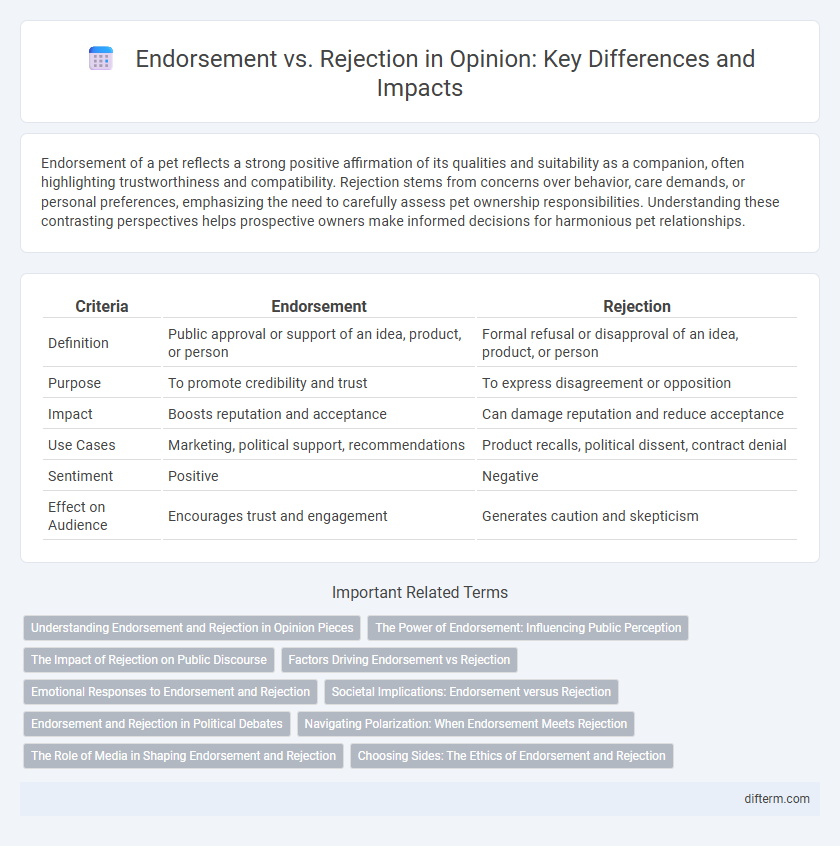Endorsement of a pet reflects a strong positive affirmation of its qualities and suitability as a companion, often highlighting trustworthiness and compatibility. Rejection stems from concerns over behavior, care demands, or personal preferences, emphasizing the need to carefully assess pet ownership responsibilities. Understanding these contrasting perspectives helps prospective owners make informed decisions for harmonious pet relationships.
Table of Comparison
| Criteria | Endorsement | Rejection |
|---|---|---|
| Definition | Public approval or support of an idea, product, or person | Formal refusal or disapproval of an idea, product, or person |
| Purpose | To promote credibility and trust | To express disagreement or opposition |
| Impact | Boosts reputation and acceptance | Can damage reputation and reduce acceptance |
| Use Cases | Marketing, political support, recommendations | Product recalls, political dissent, contract denial |
| Sentiment | Positive | Negative |
| Effect on Audience | Encourages trust and engagement | Generates caution and skepticism |
Understanding Endorsement and Rejection in Opinion Pieces
Endorsement in opinion pieces signals support or approval for an idea, policy, or individual, often backed by persuasive evidence and clear reasoning to influence public perception. Rejection involves critically opposing or disapproving a concept, highlighting flaws, inconsistencies, or negative consequences with analytical arguments. Understanding the nuances of endorsement versus rejection allows readers to better evaluate the credibility and intent behind opinion narratives.
The Power of Endorsement: Influencing Public Perception
Endorsement significantly shapes public perception by lending credibility and trust to ideas, products, or individuals through authoritative or relatable voices. In contrast, rejection often triggers skepticism and can diminish confidence, but endorsements carry the unique power to inspire acceptance and momentum in public opinion. Leveraging endorsements from influential figures or organizations amplifies the impact, making endorsement a strategic tool in shaping collective attitudes and behaviors.
The Impact of Rejection on Public Discourse
Rejection in public discourse often intensifies polarization, limiting open dialogue and reducing opportunities for consensus-building. When viewpoints are dismissed outright, individuals may become entrenched in their beliefs, hindering constructive debate and mutual understanding. The absence of endorsement can marginalize alternative perspectives, weakening diverse contributions essential for a healthy democratic process.
Factors Driving Endorsement vs Rejection
Factors driving endorsement often include perceived benefits, trust in the source, and alignment with personal values or goals. Rejection tends to stem from skepticism, perceived risks, or conflicting beliefs and experiences. Social influence and past outcomes also play crucial roles in shaping approval or disapproval decisions.
Emotional Responses to Endorsement and Rejection
Endorsement triggers positive emotional responses such as validation, increased self-esteem, and motivation, reinforcing individuals' sense of belonging and confidence. Rejection often leads to feelings of hurt, anxiety, and decreased self-worth, impacting mental health and social behavior. Emotional regulation strategies are crucial for managing the psychological effects of both endorsement and rejection.
Societal Implications: Endorsement versus Rejection
Endorsement fosters social cohesion by validating shared values and promoting collective action, which reinforces cultural norms and strengthens community identity. In contrast, rejection often triggers polarization and social fragmentation, exacerbating divisions and undermining trust in institutions. The societal implications of these responses shape public discourse, influence policymaking, and impact the overall stability of social systems.
Endorsement and Rejection in Political Debates
Endorsement in political debates strengthens a candidate's credibility by publicly aligning influential figures with their policies, thereby shaping voter perceptions positively. Rejection, on the other hand, highlights policy disagreements or character flaws, often polarizing the electorate and intensifying conflict between competing parties. Both endorsement and rejection serve crucial roles in framing the narrative and influencing electoral outcomes.
Navigating Polarization: When Endorsement Meets Rejection
Endorsement and rejection often intensify polarization, shaping public discourse by amplifying divisions rather than fostering dialogue. Navigating this divide requires recognizing the persuasive power of endorsements in legitimizing viewpoints while understanding that rejections can reinforce group identity and resistance. Balancing these forces demands strategic communication that acknowledges underlying values to bridge ideological gaps.
The Role of Media in Shaping Endorsement and Rejection
Media platforms significantly influence public endorsement and rejection by framing narratives that shape perceptions and opinions. Through selective coverage, persuasive language, and visual storytelling, media can amplify support for certain ideas while simultaneously marginalizing opposing views. The consolidation of media ownership intensifies this impact, as dominant outlets often guide collective sentiment toward endorsement or rejection of social and political issues.
Choosing Sides: The Ethics of Endorsement and Rejection
Choosing sides in endorsement and rejection carries significant ethical implications that influence personal integrity and social responsibility. Endorsing a position aligns an individual with its values and consequences, requiring careful evaluation of the underlying principles and potential impacts. Rejecting a stance involves ethical judgment that can either uphold moral standards or contribute to polarization, emphasizing the importance of deliberate and informed decision-making.
endorsement vs rejection Infographic

 difterm.com
difterm.com